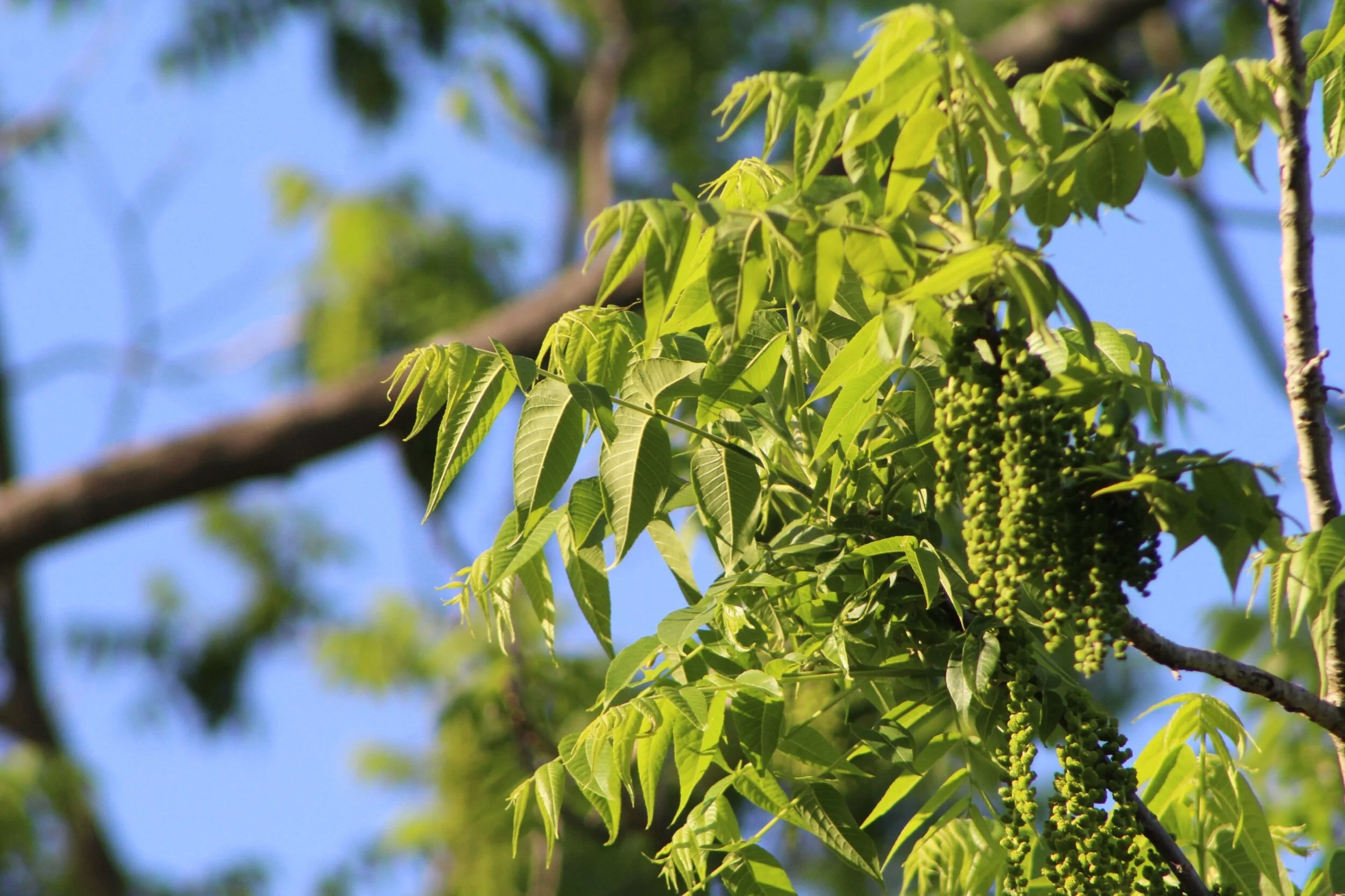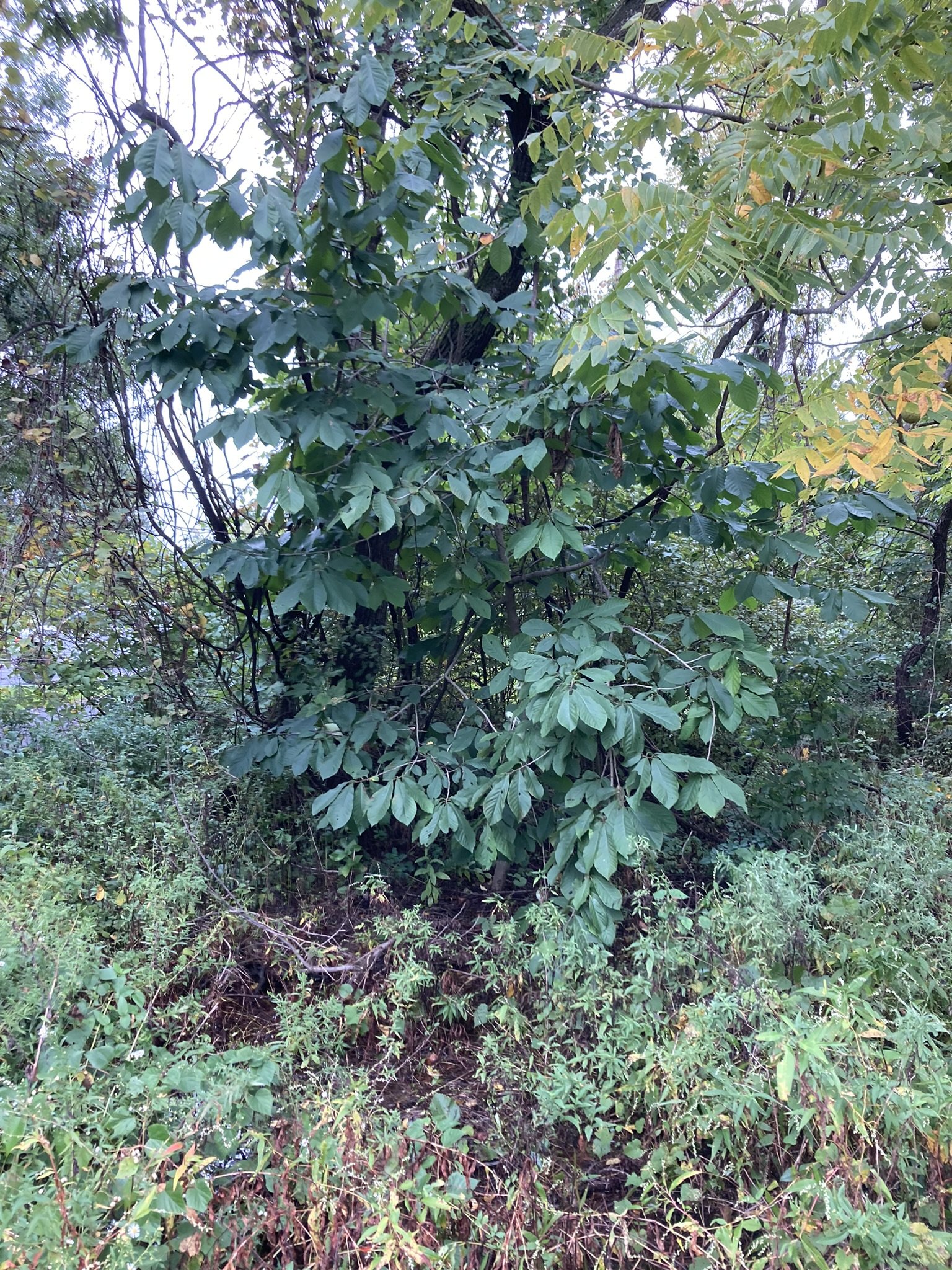Range
The Black Walnut is native throughout the eastern United States, from the Atlantic Coast, west to Colorado and Wyoming, and south to Texas.
However, even within it’s range, it shows significant genetic diversity. Studies have shown that genetics between any two stands of Black Walnuts is 3 to 5 times more varied than within the same stand. These lead to local populations with similar walnut quality, timber form, resistance to diseases, growth rate, and many other qualities of the tree. It’s also been shown that seed from southern locations will grow faster than seeds procured from north of the planting site. Incredibly, the seed remembers the summer length that it’s parents went through, and will stop growing when it anticipates the end of summer back in it’s previous northern home. On average, growth stopped 1 day early for every 24 miles north that the seeds came from.
This is one example amongst many of the Black Walnut’s amazing ability to adapt locally to changing environmental conditions and disease pressures . This makes the Black Walnut one of the most robust native species in our area.
Growing Conditions
Black Walnut requires full sun. It grows slowly in the shade and is quickly outgrown by other faster growing more shade tolerant species. This is why it is often found alone or at the edges of woodland areas.
The best soil for Black Walnuts is deep, well drained, and fertile with a roughly neutral pH. However, Black Walnuts seem to be able to grow almost anywhere and in a wide range of soil conditions, and can handle pH ranges between 4.3 - 8.2. They are very common around stream, lakes, and periodically shallow flooded streambanks.
The roots of the Black Walnut go deep with an initial taproot, however, like most trees the root system quickly changes to a wide, stable, and strong network closer to the soil surface. The roots are even somewhat flood tolerant, able to survive up to 90 days submerged depending on the time of year.
Identification
Black Walnut is relatively easy to identify in our area, but can be confused with 2 other species specifically, the invasive Tree of Heaven, and Staghorn Sumac. Butternut is also a look-a-like, but it is not common in our area and the nut is very different (oval and brown instead of round and black).
The quickest and most accurate way to identify a black walnut during a drive by or brisk hike is to first look at the leaves.
Leaves - Pinnately compound leaves with finely serrated leaflets. However, Tree of Heaven and Sumac also has similar looking leaves, so;
Look at the bark - Only Black Walnut has a rugged looking ridged bark, both of the other 2 have relatively smooth bark. This is the main way to differentiate between the Black Walnut and the other 2.
Growth Habit - Sumac grows more in closely spaced colonies, with many thinner trunks.
If you have more time and can get your hands on a leaf, do 2 things:
Look at the leaflets. The Tree of Heaven leaflets have 2 outgrowths at the base of each leaflet with stinky glands at the tips.
Smell the leaves! - Black Walnut leaves have a sharp green citrus-y smell. Tree of Heaven is reported to smell like “rancid peanut butter” or “well worn gym socks”. You will know the difference.
Use a knife to cut open the branch length-wise (like you are filleting a fish). The Black Walnut will have a what looks like stacked hollow disks inside the pith of the branch, the other 2 will not. This is a dead giveaway for a Juglans species.
Once you spend enough time looking for these, you will able to tell a Black Walnut just by the leaves after a quick glance. Try is out, you will be surprised just how many Black Walnuts are in your local parks.
Note: like I mentioned, Butternut (Juglans cinera) is also a look-a-like but is not common. If the fruit is on the tree, it will be easy to tell them apart from Black Walnut during a quick hike. However, if there are no fruit, you will need to take a closer look at the leaf scars and leaflet hairs. Its hard to describe the differences, but pictures are worth a thousand words! These 2 sites are excellent guides on telling these apart.:
2nd Note: I have actually come across Carpathian Walnut (Juglans regia) as well. These are the kind you buy in the store, and are native to Europe. However, I have only seen these in urban areas where I assume they were intentionally planted. If you see a tree with with Black Walnut-like fruit, but it has huge leaflets and only 5-7 leaflets, it’s probably a Carpathian (aka English) Walnut. See the following site for details on this tree:
Flowering & Reproduction
The Black Walnut tree is monoecious, meaning that it has both male and female flowers on the same tree. Like many trees that want to avoid self pollination, it has developed a system to avoid self-pollination called Protogyny. This is where the female flowers open first and then close before the male flowers open. This helps to ensure that pollen comes from other nearby trees other than itself. However, the Black Walnut is not self sterile and can self pollinate if a male flower were to open early, or a female flower were to stay open too long.
The flowers open April through May. The female flowers are small, with a obvious ovary at the base of 2 yellow fuzzy looking stigmas. They are usually in sets of 2 or 3 at the tips of the branches. The male flowers grow as drooping catkins. For reference, the picture of male flowers (catkins) on the left was taken on May 25th in Newark.
The walnuts grow from the ovary of the female flower, usually in pairs at the branch tips. This brings up the reason for the name Juglans, which comes from the latin words for Jupiter and glands… you can work out the rest.
Walnuts mature in the same growing season, and fall from the tree shortly after the leaves drop in October.
Propagation
If you can beat the squirrels, walnuts are easy to gather for growing your own. The best places to find walnuts are in isolated areas and along roadsides where squirrels are less common. The walnut husks can then be removed with mechanical agitation, or simply planted whole. ( I strongly recommend this video by Edible Acres on processing Black Walnuts!). Black Walnuts need to experience the winter cold (stratification) in order to break dormancy and spout the following spring. (if a squirrel doesn’t find them first)
This can also be accomplished indoors in a controlled and protected environment by sticking the nuts in the fridge for at least 3-4 months. However, some nuts will not germinate the following year and instead require a second winter or cold treatment to germinate.
Black Walnut will also grow stump sprouts after a tree is cut down or damaged by fire.
Finally, Black Walnuts take very well to grafting, which together with their genetic variability, makes it very easy to select and start a cultivar of any particular tree. Inlay grafting seems to be the most successful technique for Black Walnuts.
Ecology
Black Walnuts account for 10% of the total diet of Eastern Fox Squirrel. Most squirrels in the eastern US depend on trees like Black Walnuts, Hickories, and Oaks for their winter diets.
The massive canopy of a mature tree provides cover for bids and owls.
The leaves provide the most benefit for local wildlife, feeding over 100 species of butterflies and moths, including the Luna Moth, Regal Moth, Imperial Moth, Walnut Sphinx Moth, Fall Webworm Moth, Walnut Caloptila, Pecan Leafminer Month, Monkey Slug Moth, and many others.
Food
Black Walnuts mature around 20 years old, where they produce the most Walnuts. However, they typically start Walnut production around 8 years after started from seed, and even earlier for grafted cultivars. Like oaks, they also tend to periodically produce especially large crops every 2-5 years.
Ice cream, cookies, so many possibilities.
Home Landscaping
The Black Walnut usually grows to around 75ft tall, but can grow up to 125-150 ft tall on very excellent sites.
History & Traditional Use
Native Americans used the nuts for food and extracted black dye from the roots. The black walnut is mentioned in Native American creation myths (2)
The ground shells of black walnut are used as a nonslip agent in automobile tires, as an air pressure propellant in strip paints, and as a filtering agent for scrubbers in smoke stacks. The automobile industry uses the ground shell products to deburr precision gears, and the airline industry uses the ground shells to clean jet engines (2)
Credits and more information than you could ask for!
US Forest Service (https://www.srs.fs.usda.gov/pubs/misc/ag_654/volume_2/juglans/nigra.htm)
USDS Fire Effects Information System (https://www.fs.usda.gov/database/feis/plants/tree/jugnig/all.html#41)
Maryland Department of Natural Resources (https://news.maryland.gov/dnr/2021/06/21/native-plant-profile-black-walnut-juglans-nigra/)
Tree of the Week (https://www.youtube.com/watch?v=w2oaffYUb1E)
Ohioense (http://bobklips.com/treeflowers1.html)
bplant page (https://bplant.org/plant/575)
The Essential Walnut Guide (https://thepolycultureproject.medium.com/the-essential-guide-to-everything-you-need-to-know-about-growing-walnuts-juglans-regia-9eb4a2c80df3)
.













































